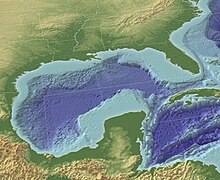
Back Golf van Meksiko Afrikaans የሜክሲኮ ባሕር ሥላጤ Amharic خليج المكسيك Arabic ܒܪܩܩܐ ܕܡܟܣܝܩܘ ARC خليج الميكسيك ARZ Golfu de Méxicu AST Meksika körfəzi Azerbaijani مکزیک خلیجی AZB Мексика ҡултығы Bashkir Goif vo Mexiko BAR

The Gulf of Mexico is an ocean basin or bay of the Atlantic Ocean. It is a marginal sea of North America. The United States of America, Mexico, and Cuba are the countries around it.
The Straits of Florida connect to the rest of the Atlantic Ocean, and the Yucatán Channel connects to the Caribbean Sea. Because of its narrow connection to the Atlantic Ocean, the Gulf has very small tides.
The size of the Gulf basin is about 1.6 million km2 (615,000 sq mi). Almost half of the basin is shallow continental-shelf waters. The climate is tropical, with heavy growth of plankton and sea grass.
Petroleum is found near the north and west coast of this gulf. Many hurricanes hit this area, for example, Hurricane Katrina and Hurricane Rita hurt many of the oil wells in 2005 in the United States. There is also a big fishing industry in the gulf. The Gulf of Mexico is one of the most important offshore petroleum-production regions in the world, making one-sixth of the United States' total production.[1]
The Gulf was formed by plate tectonics about 300 million years ago.[2]
- ↑ "Gulf of Mexico Fact Sheet". U.S. Energy Information Administration. Archived from the original on December 18, 2020. Retrieved March 26, 2018.
- ↑ Huerta A.D. & Harry D.L. 2012. Wilson cycles, tectonic inheritance, and rifting of the North American Gulf of Mexico continental margin. Geosphere. 8(1):GES00725.1, March 6, 2012. doi:10.1130/GES00725.1